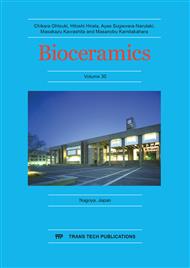p.53
p.59
p.65
p.72
p.78
p.84
p.91
p.98
p.103
Bioactivity Assessment of Apatite Nuclei-PVDF Composite Thin Films
Abstract:
Particles of calcium phosphate were precipitated by raising the temperature and the pH of simulated body fluid (SBF) named Apatite Nuclei (AN). AN and polyvinylidene fluoride (PVDF) composites thin films with different weight percentages of AN in PVDF were fabricated by solution casting technique, using doctor blade method. In order to assess the bioactivity, the thin films were soaked in simulated body fluid (SBF). It was found that the film containing 30 wt.% of AN in PVDF actively induced hydroxyapatite formation in 3 days soaking period in SBF.
Info:
Periodical:
Pages:
78-83
Citation:
Online since:
October 2018
Authors:
Price:
Сopyright:
© 2018 Trans Tech Publications Ltd. All Rights Reserved
Share:
Citation:


